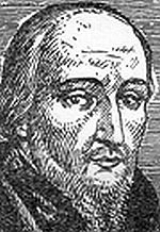
Ambrose Barlow
Encyclopedia
Ambrose Edward Barlow, O.S.B.
, (1585 – 10 September 1641) was an English Benedictine monk who is venerated as a saint
in the Catholic Church. He is one of a group of saints canonized by Pope Paul VI
who became known as the Forty Martyrs of England and Wales
.
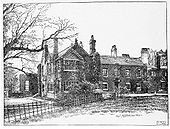 Ambrose was born at Barlow Hall
Ambrose was born at Barlow Hall
, Chorlton-cum-Hardy
, near Manchester
in 1585. He was the fourth son of the nobleman Sir Alexander Barlow and his wife Mary, daughter of Sir Uryan Brereton. The Barlow family had been reluctant converts to the Church of England
following the suppression of the Church of Rome
in England and Wales
. Ambrose's grandfather died in 1584 whilst imprisoned for his beliefs and Sir Alexander Barlow had two thirds of his estate confiscated as a result of his refusing to conform with the rules of the new established religion. On 30 November 1585, Ambrose was baptised at Didsbury
chapel and went on to adhere to the Anglican
faith until 1607, when he converted to Roman Catholicism
.
In 1597, Ambrose was taken into the stewardship of Sir Uryan Legh, a relative who would care for him whilst he served out his apprenticeship
as a page
. However, upon completing this service, Barlow realised that his true vocation was for the priest
hood, so he travelled to Douai
in France
to study at the English College
there before attending the Royal College of Saint Alban
in Valladolid
, Spain
. In 1615, he returned to Douai where he became a member of the Order of Saint Benedict
and was ordained as a priest in 1617.
, Astley
. Sir Thomas' grandmother had arranged for a pension to be made available to the priest which would enable him to carry out his priestly duties amongst the poor Catholics within his parish. From there he secretly catered for the needs of Catholic 'parishioners', offering daily Mass and reciting his Office and Rosary. To avoid detection by the Protestant authorities, he devised a four week routine in which he travelled throughout the parish for four weeks and then remained within the Hall for five weeks. He would often visit his cousins, the Downes, at their residence of Wardley Hall
and conduct Mass for the gathered congregation.
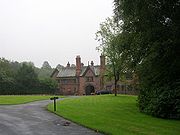 Ambrose was arrested several times during his travels. King Charles I signed a proclamation on the 7 March 1641, which decreed that all priests should leave the country within one calendar month or face being arrested and treated as traitors, resulting in imprisonment or death. Ambrose's parishioners implored him to flee or at least go into hiding but he refused. Their fears were compounded by a recent stroke
Ambrose was arrested several times during his travels. King Charles I signed a proclamation on the 7 March 1641, which decreed that all priests should leave the country within one calendar month or face being arrested and treated as traitors, resulting in imprisonment or death. Ambrose's parishioners implored him to flee or at least go into hiding but he refused. Their fears were compounded by a recent stroke
which had resulted in the 56-year-old priest being partially paralysed. "Let them fear that have anything to lose which they are unwilling to part with" he told them.
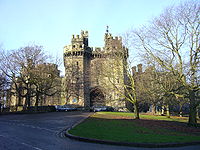 On 25 April 1641, Easter Day, Ambrose and his congregation of around 100 people, were surrounded at Morleys Hall, Astley by the Vicar of Leigh and his armed congregation of some 400. Father Ambrose surrendered, and his parishioners were released after their names had been recorded. The priest was restrained, then taken on a horse with a man behind him to prevent his falling, and escorted by a band of sixty people to the Justice of the Peace at Winwick
On 25 April 1641, Easter Day, Ambrose and his congregation of around 100 people, were surrounded at Morleys Hall, Astley by the Vicar of Leigh and his armed congregation of some 400. Father Ambrose surrendered, and his parishioners were released after their names had been recorded. The priest was restrained, then taken on a horse with a man behind him to prevent his falling, and escorted by a band of sixty people to the Justice of the Peace at Winwick
, before being transported to Lancaster Castle
.
Father Ambrose appeared before the presiding judge, Sir Robert Heath, on the 7 September when he professed his adherence to the Catholic faith and defended his actions. On the 8 September, the feast of the Nativity of Mary
, Sir Robert Heath found Ambrose guilty, and sentenced him to be executed
. Two days later, he was taken from Lancaster Castle, drawn on a hurdle to the place of execution, hanged, dismembered, quartered, and boiled in oil. His head was afterwards exposed on a pike.
When the news of his death and martyrdom reached his Benedictine brothers at Douai Abbey, a Mass of Thanksgiving and the Te Deum
, were ordered to be sung.
proclaimed Father Ambrose as Blessed
at his Beatification
ceremony at St. Peter's Basilica
, Vatican City
. In recognition of the large number of British Roman Catholic martyrs who were executed during the Reformation
, most during the reign of Elizabeth I, Pope Paul VI
decreed that on 25 October 1970 he was canonising a number of people who were to be known as the Forty Martyrs of England and Wales
of whom Ambrose was one.
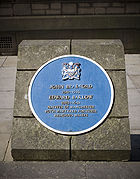 Challoner (see below) compiled Barlow's biography from two manuscripts belonging to St Gregory's Monastery, one of which was written by his brother Dom Rudesind Barlow, President of the English Benedictine Congregation
Challoner (see below) compiled Barlow's biography from two manuscripts belonging to St Gregory's Monastery, one of which was written by his brother Dom Rudesind Barlow, President of the English Benedictine Congregation
. A third manuscript, titled "The Apostolical Life of Ambrose Barlow", was written by one of his pupils for Dom Rudesind, and is presently in the John Rylands Library
, Manchester; it has been printed by the Chetham Society.
Two portraits of Barlow and one of his father, Sir Alexander, are known to exist. Many of his relics are also preserved, a hand being at Stanbrook Abbey
near Worcester
and his skull at Wardley Hall
.
are named after the saint. The church at Barlow Moor
in the parish of his birthplace, founded in 1932, is dedicated to St Ambrose of Milan but changed to St Ambrose Barlow at his canonisation. It holds the relic of his jaw bone, and his skull is preserved on the stairwell of Wardley Hall, the one time home of the Downes family, and now the home of the Catholic bishop of Salford.
Order of Saint Benedict
The Order of Saint Benedict is a Roman Catholic religious order of independent monastic communities that observe the Rule of St. Benedict. Within the order, each individual community maintains its own autonomy, while the organization as a whole exists to represent their mutual interests...
, (1585 – 10 September 1641) was an English Benedictine monk who is venerated as a saint
Saint
A saint is a holy person. In various religions, saints are people who are believed to have exceptional holiness.In Christian usage, "saint" refers to any believer who is "in Christ", and in whom Christ dwells, whether in heaven or in earth...
in the Catholic Church. He is one of a group of saints canonized by Pope Paul VI
Pope Paul VI
Paul VI , born Giovanni Battista Enrico Antonio Maria Montini , reigned as Pope of the Catholic Church from 21 June 1963 until his death on 6 August 1978. Succeeding Pope John XXIII, who had convened the Second Vatican Council, he decided to continue it...
who became known as the Forty Martyrs of England and Wales
Forty Martyrs of England and Wales
The Forty Martyrs of England and Wales are a group of men and women who were executed for treason and related offences in the Kingdom of England between 1535 and 1679...
.
Early life and education

Barlow Hall
Barlow Hall is an ancient manor house and Grade II listed building in Chorlton-cum-Hardy in the suburbs of Manchester, England. A house has existed on the site since at least the 13th century, but the present building dates back no further than the 16th century , with additions having been made later...
, Chorlton-cum-Hardy
Chorlton-cum-Hardy
Chorlton-cum-Hardy is a suburban area of the city of Manchester, England. It is known locally as Chorlton. It is situated about four miles southwest of Manchester city centre. Pronunciation varies: and are both common....
, near Manchester
Manchester
Manchester is a city and metropolitan borough in Greater Manchester, England. According to the Office for National Statistics, the 2010 mid-year population estimate for Manchester was 498,800. Manchester lies within one of the UK's largest metropolitan areas, the metropolitan county of Greater...
in 1585. He was the fourth son of the nobleman Sir Alexander Barlow and his wife Mary, daughter of Sir Uryan Brereton. The Barlow family had been reluctant converts to the Church of England
Church of England
The Church of England is the officially established Christian church in England and the Mother Church of the worldwide Anglican Communion. The church considers itself within the tradition of Western Christianity and dates its formal establishment principally to the mission to England by St...
following the suppression of the Church of Rome
Roman Catholic Church
The Catholic Church, also known as the Roman Catholic Church, is the world's largest Christian church, with over a billion members. Led by the Pope, it defines its mission as spreading the gospel of Jesus Christ, administering the sacraments and exercising charity...
in England and Wales
England and Wales
England and Wales is a jurisdiction within the United Kingdom. It consists of England and Wales, two of the four countries of the United Kingdom...
. Ambrose's grandfather died in 1584 whilst imprisoned for his beliefs and Sir Alexander Barlow had two thirds of his estate confiscated as a result of his refusing to conform with the rules of the new established religion. On 30 November 1585, Ambrose was baptised at Didsbury
Didsbury
Didsbury is a suburban area of the City of Manchester, in Greater Manchester, England. It lies on the north bank of the River Mersey, south of Manchester city centre, in the southern half of the Greater Manchester Urban Area...
chapel and went on to adhere to the Anglican
Anglicanism
Anglicanism is a tradition within Christianity comprising churches with historical connections to the Church of England or similar beliefs, worship and church structures. The word Anglican originates in ecclesia anglicana, a medieval Latin phrase dating to at least 1246 that means the English...
faith until 1607, when he converted to Roman Catholicism
Roman Catholic (term)
The term Roman Catholic appeared in the English language at the beginning of the 17th century, to differentiate specific groups of Christians in communion with the Pope from others; comparable terms in other languages already existed...
.
In 1597, Ambrose was taken into the stewardship of Sir Uryan Legh, a relative who would care for him whilst he served out his apprenticeship
Apprenticeship
Apprenticeship is a system of training a new generation of practitioners of a skill. Apprentices or protégés build their careers from apprenticeships...
as a page
Page (servant)
A page or page boy is a traditionally young male servant, a messenger at the service of a nobleman or royal.-The medieval page:In medieval times, a page was an attendant to a knight; an apprentice squire...
. However, upon completing this service, Barlow realised that his true vocation was for the priest
Priest
A priest is a person authorized to perform the sacred rites of a religion, especially as a mediatory agent between humans and deities. They also have the authority or power to administer religious rites; in particular, rites of sacrifice to, and propitiation of, a deity or deities...
hood, so he travelled to Douai
Douai
-Main sights:Douai's ornate Gothic style belfry was begun in 1380, on the site of an earlier tower. The 80 m high structure includes an impressive carillon, consisting of 62 bells spanning 5 octaves. The originals, some dating from 1391 were removed in 1917 during World War I by the occupying...
in France
France
The French Republic , The French Republic , The French Republic , (commonly known as France , is a unitary semi-presidential republic in Western Europe with several overseas territories and islands located on other continents and in the Indian, Pacific, and Atlantic oceans. Metropolitan France...
to study at the English College
English College, Douai
The English College, Douai was a Catholic seminary associated with the University of Douai . It was established in about 1561, and was suppressed in 1793...
there before attending the Royal College of Saint Alban
English College, Valladolid
The Royal English and Welsh College, Valladolid, under the patronage of St Alban, was founded in 1589 during the protestant reformation for the training of Catholic priests for the English and Welsh Mission....
in Valladolid
Valladolid
Valladolid is a historic city and municipality in north-central Spain, situated at the confluence of the Pisuerga and Esgueva rivers, and located within three wine-making regions: Ribera del Duero, Rueda and Cigales...
, Spain
Spain
Spain , officially the Kingdom of Spain languages]] under the European Charter for Regional or Minority Languages. In each of these, Spain's official name is as follows:;;;;;;), is a country and member state of the European Union located in southwestern Europe on the Iberian Peninsula...
. In 1615, he returned to Douai where he became a member of the Order of Saint Benedict
Order of Saint Benedict
The Order of Saint Benedict is a Roman Catholic religious order of independent monastic communities that observe the Rule of St. Benedict. Within the order, each individual community maintains its own autonomy, while the organization as a whole exists to represent their mutual interests...
and was ordained as a priest in 1617.
Mission
After his ordination into the priesthood, Ambrose returned to Barlow Hall, before taking up residence at the home of Sir Thomas Tyldesley, Morleys HallMorleys Hall
Morleys Hall, a moated hall converted to two houses, is situated at on Morleys Lane, on the edge of Astley Moss in Astley, Greater Manchester, England. It was largely rebuilt in the 19th century on the site of a medieval timber house. The hall is a Grade II* listed building and the moat a...
, Astley
Astley, Greater Manchester
Astley is a settlement within the Metropolitan Borough of Wigan in Greater Manchester, England, variously described as a suburb or a village. Astley lies on flat land to the northwest of the city of Manchester, and is crossed by the Bridgewater Canal and the A580 "East Lancashire Road"...
. Sir Thomas' grandmother had arranged for a pension to be made available to the priest which would enable him to carry out his priestly duties amongst the poor Catholics within his parish. From there he secretly catered for the needs of Catholic 'parishioners', offering daily Mass and reciting his Office and Rosary. To avoid detection by the Protestant authorities, he devised a four week routine in which he travelled throughout the parish for four weeks and then remained within the Hall for five weeks. He would often visit his cousins, the Downes, at their residence of Wardley Hall
Wardley Hall
Wardley Hall is an early medieval manor house and a Grade I listed building in the Wardley area of Worsley, in Greater Manchester . . There has been a moat on the site since at least 1292. The current hall dates from around 1500 but was extensively rebuilt in the 19th and 20th centuries. The 1894...
and conduct Mass for the gathered congregation.
Arrest and execution

Stroke
A stroke, previously known medically as a cerebrovascular accident , is the rapidly developing loss of brain function due to disturbance in the blood supply to the brain. This can be due to ischemia caused by blockage , or a hemorrhage...
which had resulted in the 56-year-old priest being partially paralysed. "Let them fear that have anything to lose which they are unwilling to part with" he told them.

Winwick, Cheshire
Winwick is a village and civil parish in the borough of Warrington in Cheshire, England. Historically within Lancashire, until 1 April 1974, Winwick was administered as part of Lancashire with the rest of north Warrington. It is situated about three miles north of Warrington town centre, near...
, before being transported to Lancaster Castle
Lancaster Castle
Lancaster Castle is a medieval castle located in Lancaster in the English county of Lancashire. Its early history is unclear, but may have been founded in the 11th century on the site of a Roman fort overlooking a crossing of the River Lune. In 1164, the Honour of Lancaster, including the...
.
Father Ambrose appeared before the presiding judge, Sir Robert Heath, on the 7 September when he professed his adherence to the Catholic faith and defended his actions. On the 8 September, the feast of the Nativity of Mary
Nativity of Mary
The Nativity of Mary, or Birth of the Virgin and various permutations, is celebrated as a liturgical feast in the Roman Catholic calendar of saints and in most Anglican liturgical calendars on 8 September, nine months after the solemnity of her Immaculate Conception, celebrated on 8 December...
, Sir Robert Heath found Ambrose guilty, and sentenced him to be executed
Hanged, drawn and quartered
To be hanged, drawn and quartered was from 1351 a penalty in England for men convicted of high treason, although the ritual was first recorded during the reigns of King Henry III and his successor, Edward I...
. Two days later, he was taken from Lancaster Castle, drawn on a hurdle to the place of execution, hanged, dismembered, quartered, and boiled in oil. His head was afterwards exposed on a pike.
When the news of his death and martyrdom reached his Benedictine brothers at Douai Abbey, a Mass of Thanksgiving and the Te Deum
Te Deum
The Te Deum is an early Christian hymn of praise. The title is taken from its opening Latin words, Te Deum laudamus, rendered literally as "Thee, O God, we praise"....
, were ordered to be sung.
Canonisation
On 15 December 1929, Pope Pius XIPope Pius XI
Pope Pius XI , born Ambrogio Damiano Achille Ratti, was Pope from 6 February 1922, and sovereign of Vatican City from its creation as an independent state on 11 February 1929 until his death on 10 February 1939...
proclaimed Father Ambrose as Blessed
Beatification
Beatification is a recognition accorded by the Catholic Church of a dead person's entrance into Heaven and capacity to intercede on behalf of individuals who pray in his or her name . Beatification is the third of the four steps in the canonization process...
at his Beatification
Beatification
Beatification is a recognition accorded by the Catholic Church of a dead person's entrance into Heaven and capacity to intercede on behalf of individuals who pray in his or her name . Beatification is the third of the four steps in the canonization process...
ceremony at St. Peter's Basilica
St. Peter's Basilica
The Papal Basilica of Saint Peter , officially known in Italian as ' and commonly known as Saint Peter's Basilica, is a Late Renaissance church located within the Vatican City. Saint Peter's Basilica has the largest interior of any Christian church in the world...
, Vatican City
Vatican City
Vatican City , or Vatican City State, in Italian officially Stato della Città del Vaticano , which translates literally as State of the City of the Vatican, is a landlocked sovereign city-state whose territory consists of a walled enclave within the city of Rome, Italy. It has an area of...
. In recognition of the large number of British Roman Catholic martyrs who were executed during the Reformation
Protestant Reformation
The Protestant Reformation was a 16th-century split within Western Christianity initiated by Martin Luther, John Calvin and other early Protestants. The efforts of the self-described "reformers", who objected to the doctrines, rituals and ecclesiastical structure of the Roman Catholic Church, led...
, most during the reign of Elizabeth I, Pope Paul VI
Pope Paul VI
Paul VI , born Giovanni Battista Enrico Antonio Maria Montini , reigned as Pope of the Catholic Church from 21 June 1963 until his death on 6 August 1978. Succeeding Pope John XXIII, who had convened the Second Vatican Council, he decided to continue it...
decreed that on 25 October 1970 he was canonising a number of people who were to be known as the Forty Martyrs of England and Wales
Forty Martyrs of England and Wales
The Forty Martyrs of England and Wales are a group of men and women who were executed for treason and related offences in the Kingdom of England between 1535 and 1679...
of whom Ambrose was one.
Hagiography and relics

English Benedictine Congregation
The English Benedictine Congregation comprises autonomous Roman Catholic Benedictine communities of monks and nuns and is technically the oldest of the 21 congregations that are affiliated in the Benedictine Confederation....
. A third manuscript, titled "The Apostolical Life of Ambrose Barlow", was written by one of his pupils for Dom Rudesind, and is presently in the John Rylands Library
John Rylands Library
The John Rylands Library is a Victorian Gothic building on Deansgate in Manchester, England. The library, which opened to the public in 1900, was founded by Mrs Enriqueta Augustina Rylands in memory of her late husband, John Rylands...
, Manchester; it has been printed by the Chetham Society.
Two portraits of Barlow and one of his father, Sir Alexander, are known to exist. Many of his relics are also preserved, a hand being at Stanbrook Abbey
Stanbrook Abbey
Stanbrook Abbey is an abbey built as a contemplative house for Benedictine nuns. It was founded in 1625 in Cambrai, Flanders, then part of the Spanish Netherlands, under the auspices of the English Benedictine Congregation.-History:...
near Worcester
Worcester
The City of Worcester, commonly known as Worcester, , is a city and county town of Worcestershire in the West Midlands of England. Worcester is situated some southwest of Birmingham and north of Gloucester, and has an approximate population of 94,000 people. The River Severn runs through the...
and his skull at Wardley Hall
Wardley Hall
Wardley Hall is an early medieval manor house and a Grade I listed building in the Wardley area of Worsley, in Greater Manchester . . There has been a moat on the site since at least 1292. The current hall dates from around 1500 but was extensively rebuilt in the 19th and 20th centuries. The 1894...
.
Legacy
Astley's Roman Catholic church and primary school and St Ambrose Barlow RC High School in Swinton, Greater ManchesterSwinton, Greater Manchester
Swinton is a town within the City of Salford, in Greater Manchester, England. Located on the A6 road it stands on gently sloping ground on the southwest side of the River Irwell, and within the bounds of the orbital M60 motorway. It is west-northwest of Salford, and west-northwest of Manchester...
are named after the saint. The church at Barlow Moor
Barlow Moor
Barlow Moor was in early times an area of waste between Didsbury and Chorlton-cum-Hardy and was named after Barlow. Barlow Moor Road runs through the area and connects to Wilmslow Road at the southern end and Manchester Road at the northern end. Southern Cemetery and Chorlton Park are landmarks on...
in the parish of his birthplace, founded in 1932, is dedicated to St Ambrose of Milan but changed to St Ambrose Barlow at his canonisation. It holds the relic of his jaw bone, and his skull is preserved on the stairwell of Wardley Hall, the one time home of the Downes family, and now the home of the Catholic bishop of Salford.
Sources
- Allanson, Biographical MSS. (preserved at Ampleforth Abbey): MS. I
- Dodd, Charles (1739) Church History of England. Brussels
- Gillow, JosephJoseph GillowJoseph Gillow was an English Roman Catholic antiquary and bio-bibliographer, "the Plutarch of the English Catholics"....
(1885) Bibliographical Dictionary of English Catholics. London - Moss, Fletcher (1903) Pilgrimages to Old Homes book 2. Didsbury: F. Moss
- idem (1891) Didsbury. Manchester
- idem (1894) Chronicles of Cheadle, Cheshire. Didsbury: F. Moss
- Rhodes, W. E. (ed.) (1909) The Apostolical Life of Ambrose Barlow. Manchester: Chetham Society
- Challoner, RichardRichard ChallonerRichard Challoner was an English Roman Catholic bishop, a leading figure of English Catholicism during the greater part of the 18th century. He is perhaps most famous for his revision of the Douay Rheims translation of the Bible.-Early life:Challoner was born in the Protestant town of Lewes,...
; John Hungerford Pollen, ed.) (1924) Memoirs of Missionary Priests - Camm, BedeBede CammReginald Bede Camm was an English Benedictine martyrologist. A monk of Erdington Abbey, he is known for works on the English Catholic martyrs.-Life:...
(1931) Nine Martyr Monks - New Catholic Encyclopedia (1967)
- Butler, Alban (2000) Lives of the Saints, vol. 9 (revised ed.)

